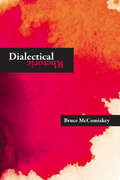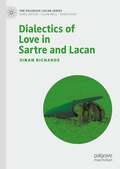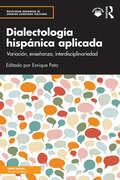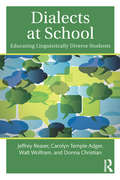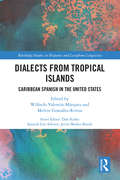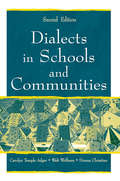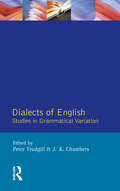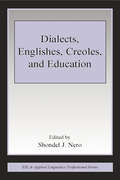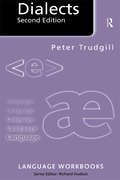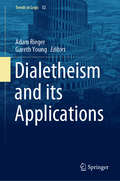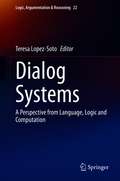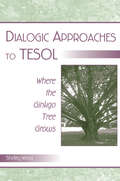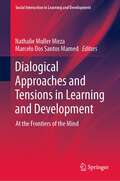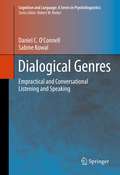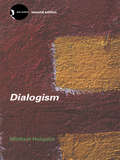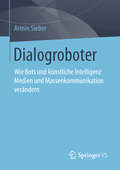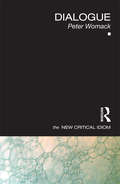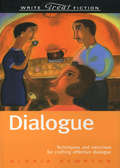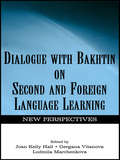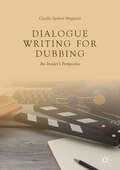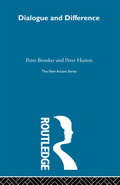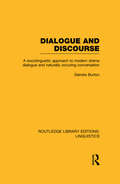- Table View
- List View
Dialectical Rhetoric
by Bruce MccomiskeyIn Dialectical Rhetoric, Bruce McComiskey argues that the historical conflict between rhetoric and dialectic can be overcome in ways useful to both composition theory and the composition classroom. Historically, dialectic has taken two forms in relation to rhetoric. First, it has been the logical development of linear propositions leading to necessary conclusions, a one-dimensional form that was the counterpart of rhetorics in which philosophical, metaphysical, and scientific truths were conveyed with as little cognitive interference from language as possible. Second, dialectic has been the topical development of opposed arguments on controversial issues and the judgment of their relative strengths and weaknesses, usually in political and legal contexts, a two-dimensional form that was the counterpart of rhetorics in which verbal battles over competing probabilities in public institutions revealed distinct winners and losers. The discipline of writing studies is on the brink of developing a new relationship between dialectic and rhetoric, one in which dialectics and rhetorics mediate and negotiate different arguments and orientations that are engaged in any rhetorical situation. This new relationship consists of a three-dimensional hybrid art called “dialectical rhetoric,” whose method is based on five topoi: deconstruction, dialogue, identification, critique, and juxtaposition. Three-dimensional dialectical rhetorics function effectively in a wide variety of discursive contexts, including digital environments, since they can invoke contrasts in stagnant contexts and promote associations in chaotic contexts. Dialectical Rhetoric focuses more attention on three-dimensional rhetorics from the rhetoric and composition community.
Dialectics of Love in Sartre and Lacan (The Palgrave Lacan Series)
by Sinan RichardsWhat is love for Sartre and Lacan? In Dialectics of Love in Sartre and Lacan, Sinan Richards examines Sartre’s and Lacan’s writings on love to draw out a distinctly Lacanian conception of love and subjectivity. Richards begins by demonstrating how Sartre’s in itself for itself is a convincing shorthand for Lacan’s central object of study, before presenting and explaining the various aspects of Lacan’s psychophilosophical project to show how, for Lacan, the subject is marked by various pathologies. He argues that, for Lacan, as for Sartre and Schelling before him, the subject is ontologically sick, and, by its very structure, the Oedipus complex produces subjects that are prey to a mental collapse at any moment. As a result, for Lacan, the subject has no choice but to identify with their potential madness, a constitutive aspect of their subjectivity. He concludes by making a compelling case that love in the Lacanian schema is the subject’s mad wish to reunite in itself with for itself, which is an always impossible yet necessary aspect of subjectivity. The book presents fresh insights on Lacan and Sartre that will appeal to students and scholars of psychoanalysis, philosophy, comparative literature and critical theory.
Dialectology and the Linguistic Atlas Project (Elements in Sociolinguistics)
by Allison BurkettePeople from different places use different words for things, even everyday things such as carbonated beverages (e.g. soda, coke, pop) or bread roll-based sandwiches (e.g. hoagie, grinder, sub). Regional variation in vocabulary is one of the foci of dialectology, a subfield of linguistics that examines the geographic distribution of specific words, along with distributions of different pronunciations and grammatical constructions. This Element will provide readers with a basic understanding of traditional dialectological study and will demonstrate through examples (audio, text, maps) how Linguistic Atlas Project research has changed and expanded over time. Readers will be introduced to the key concepts of dialectology with a focus on the North American Linguistic Atlas Project (LAP) and its materials. This Element will also discuss today's LAP with reference to third-wave sociolinguistics, outlining the ways in which the LAP has changed over time to meet the needs and goals of contemporary sociolinguistic study.
Dialectología hispánica aplicada: Variación, enseñanza, interdisciplinariedad (Routledge Advances in Spanish Language Teaching)
by Enrique PatoDialectología hispánica aplicada. Variación, enseñanza, interdisciplinariedad es un libro de referencia tanto para el estudio como para la investigación en dialectología hispánica y su aplicación a la enseñanza de lenguas.El libro ha sido cuidadosamente concebido para introducir al lector en las principales áreas de las variedades del español (en España, América, Filipinas, Guinea Ecuatorial y en contacto con otras lenguas), la enseñanza de la variación (fonética, gramática, léxico y pragmática) y las relaciones de la dialectología con otras áreas y campos de especialización (lingüística formal, tipología, lingüística forense, traducción, literatura y estudios culturales), que se delimitan con claridad y precisión, proporcionando una base sólida sobre la materia.Entre sus características se incluyen: Una selección de capítulos centrados en la variación lingüística del español, la enseñanza y la interdisciplinariedad. Énfasis en las conexiones entre teoría y práctica a lo largo de todo el libro. Preguntas de aplicación y reflexión para facilitar la comprensión de cada área. Escrito íntegramente en español con aplicabilidad directa del contenido en la enseñanza de la lengua. Recursos electrónicos que incluyen material adicional, como audios y vídeos, disponibles en www.routledge.com/9781032754581. Escrito de manera clara y accesible, Dialectología hispánica aplicada puede utilizarse como texto independiente o como lectura complementaria tanto para profesores como para estudiantes. El libro también será de interés para estudiantes de posgrado que realicen investigaciones sobre variación lingüística, lingüística hispánica y enseñanza del español (ELE).______________________________________________________________________________________________Dialectología hispánica aplicada introduces the reader to the main areas of Hispanic dialectology and its application to Spanish Language Teaching, with an emphasis on the connections between theory and practice throughout the book.The varieties of Spanish (in Spain, America, Philippines, Equatorial Guinea, and in contact with other languages), the teaching of variation, and the relations of dialectology with other areas of specialization provide an integral foundation in the field. Through the comparison of accents, the identification of grammatical features, the analysis of the specific lexicon, the creation of dialect maps, the use of linguistic corpora, and other similar resources, this collaborative volume uniquely enables readers to identify variants, geographically locate dialectal phenomena, and to compare linguistics features of different varieties.Features include: A selection of chapters focusing on linguistic variation of Spanish, teaching and interdisciplinarity; Application and reflection questions to facilitate the comprehension of each area; Written entirely in Spanish with direct applicability of the content in the teaching of the language; A wealth of online resources, including audio clips and videos, available at www.routledge.com/9781032754581 Dialectología hispánica aplicada is designed for undergraduate and graduate students, language teachers, and researchers, who need to understand the key phenomena of Hispanic Dialectology and its real impact on teaching practices. The book will also be of interest to graduate students in conducting research on Language Variation, Hispanic Linguistics and Spanish Language Teaching.
Dialects at School: Educating Linguistically Diverse Students
by Walt Wolfram Jeffrey Reaser Carolyn Temple Adger Donna ChristianLike its predecessor, Dialects in Schools and Communities, this book illuminates major language-related issues that educational practitioners confront, such as responding to dialect related features in students’ speech and writing, teaching Standard English, teaching students about dialects, and distinguishing dialect difference from language disorders. It approaches these issues from a practical perspective rooted in sociolinguistic research, with a focus on the research base for accommodating dialect differences in schools. Expanded coverage includes research on teaching and learning and attention to English language learners. All chapters include essential information about language variation, language attitudes, and principles of handling dialect differences in schools; classroom-based samples illustrating the application of these principles; and an annotated resources list for further reading. The text is supported by a Companion Website (www.routledge.com/cw/Reaser) providing additional resources including activities, discussion questions, and audio/visual enhancements that illustrate important information and/or pedagogical approaches. Comprehensive and authoritative, Dialects at School reflects both the relevant research bases in linguistics and education and educational practices concerning language variation. The problems and examples included are authentic, coming from the authors’ own research, observations and interactions in public school classrooms, and feedback in workshops. Highlights include chapters on oral language and reading and writing in dialectally diverse classrooms, as well as a chapter on language awareness for students, offering a clear and compelling overview of how teachers can inspire students to learn more about language variation, including their own community language patterns. An inventory of dialect features in the Appendix organizes and expands on the structural descriptions presented in the chapters.
Dialects from Tropical Islands: Caribbean Spanish in the United States (Routledge Studies in Hispanic and Lusophone Linguistics)
by Javier Muñoz-Basols Wilfredo Valentín-Márquez Melvin González-Rivera Dale KoikeDialects from Tropical Islands: Caribbean Spanish in the United States provides a comprehensive account of current research on Caribbean Spanish in the United States from different theoretical perspectives and linguistic areas. This edited volume highlights current scholarship and linguistic analyses in four major areas relative to Caribbean Spanish in the United States: phonological and phonetic variation, morphosyntactic approaches, sociolinguistic perspectives, and heritage-language acquisition. This volume will be of interest to linguists and philologists who specialize in Spanish, Caribbean Spanish, Spanish in the United States, or in Romance languages in general.
Dialects in Schools and Communities
by Walt Wolfram Carolyn Temple Adger Donna ChristianThis book describes dialect differences in American English and their impact on education and everyday life. It explores some of the major issues that confront educational practitioners and suggests what practitioners can do to recognize students’ language abilities, support their language development, and expand their knowledge about dialects. Topics addressed include:*popular concerns about the nature of language variation;*characteristic structures of different dialects;*various interactive patterns characteristic of social groups;*the school impacts of dialect differences in speaking, writing, and reading, including questions about teaching Standard English; and*the value of dialect education in schools to enable students to understand dialects as natural and normal language phenomena. Changes in the Second Edition: In this edition the authors reconsider and expand their discussion of many of the issues addressed in the first edition and in other of their earlier works, taking into account especially the research on dialects and publications for audiences beyond linguistics that have appeared since the first edition. This edition is offered as an updated report on the state of language variation and education in the United States. Dialects in Schools and Communities is rooted in questions that have arisen in workshops, surveys, classes, discussion groups, and conversations with practitioners and teacher educators. It is thus intended to address important needs in a range of educational and related service fields. As an overview of current empirical research, it synthesizes current understandings and provides key references—in this sense it is a kind of translation and interpretation in which the authors’ goal is to bring together the practical concerns of educators and the vantage point of sociolinguistics. No background in linguistics or sociolinguistics is assumed on the part of the reader. This volume is intended for teacher interns and practicing teachers in elementary and secondary schools; early childhood specialists; specialists in reading and writing; speech/language pathologists; special education teachers; and students in various language specialties.
Dialects of English: Studies in Grammatical Variation (Longman Linguistics Library)
by Peter Trudgill J. K. ChambersThis collection consists of 15 articles by an international group of linguists and 7 essays by the editors, tackling a broad range of issues and representing some of the most authoritative work in English dialect grammar.Individual chapters cover the full international range of English dialects, from the centre of Sydney to the shores of Newfoundland, and from the Scottish borders to the Appalachian Mountains. Soundly based on empirical research, they are rich in data of great interest in itself, but no article is merely descriptive. The editors have selected papers for their value in contributing to the reader's broader understanding of the theoretical issues concerning dialectology as a whole. As a result, dialectology is presented as a major scholarly discipline drawing creatively on such areas as linguistics, sociology, psychology, history, geography and even philosophy. These and other themes are explored in a wide-ranging Introduction by the editors, which sets the individual pieces and the subject in context for the reader.
Dialects, Englishes, Creoles, and Education (ESL & Applied Linguistics Professional Series)
by Shondel J. NeroThis volume brings together a multiplicity of voices--both theoretical and practical--on the complex politics, challenges, and strategies of educating students--in North America and worldwide--who are speakers of diverse or nonstandard varieties of English, creoles, and hybrid varieties of English, such as African American Vernacular English, Caribbean Creole English, Tex Mex, West African Pidgin English, and Indian English, among others. The number of such students is increasing as a result of the spread of English, internal and global migration, and increased educational access. Dialects, Englishes, Creoles, and Education offers:*a sociohistorical perspective on language spread and variation;*analysis of related issues such as language attitudes, identities, and prescribed versus actual language use; and*practical suggestions for pedagogy.Pedagogical features: Key points at the beginning of each chapter help focus the reader and provide a framework for reading, writing, reflection, and discussion; chapter-end questions for discussion and reflective writing engage and challenge the ideas presented and encourage a range of approaches in dealing with language diversity. Collectively, the chapters in this volume invite educators, researchers, and students, across the fields of TESOL, applied linguistics, sociolinguistics, English, literacy, and language education, to begin to consider and adopt context-specific policies and practices that will improve the language development and academic performance of linguistically diverse students.
Dialects: Respecting Vernacular Language (Language Workbooks)
by Peter TrudgillRoutledge Language Workbooks provide absolute beginners with practical introductions to core areas of language study. Books in the series provide comprehensive coverage of the area as well as a basis for further investigation. Each Language Workbook guides the reader through the subject using 'hands-on' language analysis, equipping them with the basic analytical skills needed to handle a wide range of data. Written in a clear and simple style, with all technical concepts fully explained, Language Workbooks can be used for independent study or as part of a taught class.This second edition of Dialects:*has been revised throughout *introduces the many dialects of English spoken in the United Kingdom*reveals the key issues that dialectology engages with*uses both the international phonetic alphabet and simple representations of sounds to explain pronunciations*involves readers in collecting data*contains numerous illustrative maps*is written in a lively and engaging style, with information on 'posh and less posh' dialects and spotting your dialect area.
Dialetheism and its Applications (Trends in Logic #52)
by Adam Rieger Gareth YoungThe purpose of this book is to present unpublished papers at the cutting edge of research on dialetheism and to reflect recent work on the applications of the theory. It includes contributions from some of the most respected scholars in the field, as well as from young, up-and-coming philosophers working on dialetheism.Moving from the fringes of philosophy to become a main player in debates concerning truth and the logical paradoxes, dialetheism has thrived since the publication of Graham Priest’s In Contradiction, and several of the papers find their roots in a conference on dialetheism held in Glasgow to mark the 25th anniversary of Priest’s book. The content presented here demonstrates the considerable body of work produced in this field in recent years.With a broad focus, this book also addresses the applications of dialetheism outside the more familiar area of the logical paradoxes, and includes pieces discussing the application of dialetheism in metaphysics, philosophy of language, and philosophy of mind.
Dialog Systems: A Perspective from Language, Logic and Computation (Logic, Argumentation & Reasoning #22)
by Teresa Lopez-SotoThis book focuses on dialog from a varied combination of fields: Linguistics, Philosophy of Language and Computation. It builds on the hypothesis that meaning in human communication arises at the discourse level rather than at the word level. The book offers a complex analytical framework and integration of the central areas of research around human communication. The content revolves around meaning but it also gives evidence of the connection among different points of view. Besides discussing issues of general interest to the field, the book triggers theoretical argumentation that is currently under scientific discussion. It examines such topics as immanent reasoning joined with Recanati's lekta and free enrichment, challenges of internet conversation, inner dialogs, cognition and language, and the relation between assertion and denial. It proposes a dialogical framework for intra-negotiation and gives a geolinguistic perspective on spoken discourse. Finally, it examines dialog and abduction and sheds light on a generation of dialog contexts by means of multimodal logic applied to speech acts.
Dialogic Approaches to TESOL: Where the Ginkgo Tree Grows
by Shelley WongThis book locates dialogic pedagogy within the history of TESOL approaches and methods in which the communicative approach has been the dominant paradigm. Dialogic inquiry in the form of story telling, oral histories, and knowledge from the ground up and from the margins has much to offer the field. In dialogic approaches, the teacher and students learn in community and the students' home languages and cultures, their families and communities, are seen as resources.Dialogic Approaches to TESOL: Where the Ginkgo Tree Grows explores teacher research, feminist contributions to voice, social identity and dialogic pedagogy, and the role of teachers, students, families, and communities as advocates and change agents. After a brief history of TESOL methods and an introduction to dialogic pedagogy, four features of dialogic approaches to TESOL are identified and discussed: learning in community, problem-posing, learning by doing, and who does knowledge serve? The main text in each chapter considers a single topic related to the concept of dialogic pedagogy. Branching text leads to related discussions without losing the main point of the chapter. This structure allows readers to become well-rooted in each component of dialogic pedagogy and to "branch out" into deeper philosophic understandings as well as actual practices across a range of contexts.Dialogic Approaches to TESOL offers a place for dialogue and reflection on the prospects for transforming educational institutions to serve those who have historically been excluded and marginalized. It provides questions, frameworks, and resources for those who are just beginning in the field and for U.S.-based educators who want to bring critical multicultural and multilingual perspectives into language arts, reading and literacy education.
Dialogic Editing in Academic and Professional Writing: Engaging the Trace of the Other (Routledge Research in Writing Studies)
by Özüm Üçok-Sayrak Janie Harden Fritz Kristen Lynn MajochaThis book brings attention to the communicative process of editing as a dialogic experience that is attentive to the voice of the Other, and underlines an ethical turn for the editing process. The volume focuses on an essential, yet undertheorized, aspect of the communicative practice of editing by reading and receiving the voice of the Other and offering feedback towards assisting the text to find a voice without turning it to the voice of the editor. Utilizing the theoretical and philosophical frameworks of a diverse group of leading scholars and philosophers, contributors to this volume explore the editing process as connected to communication ethics that calls for a discernment of what matters. With its philosophical underpinnings, this book will especially be of interest to researchers and students in multiple disciplines in humanities and the social sciences including communication studies, dialogue studies, philosophy, literature, composition studies, education, history, anthropology, psychology, sociology, religious studies, and political science.
Dialogical Approaches and Tensions in Learning and Development: At the Frontiers of the Mind (Social Interaction in Learning and Development)
by Nathalie Muller Mirza Marcelo Dos Santos MamedThe book pursues the goal of exploring and strengthening a dialogical approach of communication and cognition. It brings together contributions from world-leading researchers related to the dialogical approach in education and psychology. It presents, among others, the place of language and materiality in the development of communication and thinking, as well as the role of the methods in the relationship between researchers and participants. This leads to an innovative definition of the dialogicality and how a dialogical approach can provide heuristic (conceptual and methodological) tools to better understand how people think, communicate and learn in a complex world.The authors hereby develop an epistemological framework inspired by scholars such as Michaïl Bakhtin, Lev Vygotsky and Herbert Mead under the assumption that dialogue, or dialogicality - and therefore the presence of the other – is fundamentally entangled into the human thinking and development.This book contributes to the understanding of human communication, cognition and mind, and participates in a scientific dialogue which helps to advance future research. It includes theoretical and empirical chapters and presents innovative methods of inquiry, which makes it a useful tool for both teaching and research.
Dialogical Genres
by Sabine Kowal Daniel C. O'ConnellThis work gives a thorough revision of history through a psychological approach to verbal interaction between listeners and speakers. This book offers a large amount of information on the psychology of language and on psycholinguistics, and focuses on a new direction for a psychology of verbal communication. Empirical research includes media interviews, public speeches, and dramatic performances.
Dialogism: Bakhtin and His World (New Accents)
by Michael HolquistHolquist's masterly study draws on all of Bakhtin's known writings providing a comprehensive account of his achievement. Widely acknowledged as an exceptional guide to Bakhtin and dialogics, this book now includes a new introduction, concluding chapter and a fully updated bibliography. He argues that Bakhtin's work gains coherence through his commitment to the concept of dialogue, examining Bakhtin's dialogues with theorists such as Saussure, Freud, Marx and Lukacs, as well as other thinkers whose connection with Bakhtin has previously been ignored.Dialogism also includes dialogic readings of major literary texts, Mary Shelley's Frankenstein, Gogol's The Notes of a Madman and Fitzgerald's The Great Gatsby, which provide another dimension of dialogue with dialogue.
Dialogroboter: Wie Bots und künstliche Intelligenz Medien und Massenkommunikation verändern
by Armin SieberTechnologien wie künstliche Intelligenz und Natural Language Programming werden zu Auslösern der sogenannten „Dialogwende“. Darunter versteht dieses Buch die massenweise Verbreitung von autonom sprechenden Sprachdialogsystemen und automatischen Sprachassistenten. Der Autor geht der Frage nach, welche Technologien bereits zur Verfügung stehen oder bald zur Serienreife kommen. Er analysiert konkrete Verwendungen und Einsatzfelder von Bots und stellt sich die Frage, was bei der Planung und Konzeption bedacht werden muss, welche Veränderungen in Medien und Unternehmenskommunikation zu erwarten sind. Das Buch beleuchtet darüber hinaus auch die psychosozialen Folgen, die auf unsere Gesellschaft zukommen, wenn Sprachdialogsysteme in großer Zahl zum Einsatz kommen.
Dialogue (The New Critical Idiom)
by Peter WomackDialogue is a many-sided critical concept; at once an ancient philosophical genre, a formal component of fiction and drama, a model for the relationship of writer and reader, and a theoretical key to the nature of language. In all its forms, it questions ‘literature’, disturbing the singleness and fixity of the written text with the fluid interactivity of conversation. In this clear and concise guide to the multiple significance of the term, Peter Womack: outlines the history of dialogue form, looking at Platonic, Renaissance, Enlightenment and Modern examples illustrates the play of dialogue in the many ‘voices’ of the novel, and considers how dialogue works on the stage interprets the influential dialogic theories of Mikhail Bakhtin examines the idea that literary study itself consists of a ‘dialogue’ with the past presents a useful glossary and further reading section. Practical and thought-provoking, this volume is the ideal starting-point for the exploration of this diverse and fascinating literary form.
Dialogue Interpreting: A Guide to Interpreting in Public Services and the Community (Routledge Interpreting Guides)
by Rebecca Tipton Olgierda FurmanekRoutledge Interpreting Guides cover the key settings or domains of interpreting and equip trainee interpreters and students of interpreting with the skills needed in each area of the field. Concise, accessible and written by leading authorities, they include examples from existing interpreting practice, activities, further reading suggestions and a glossary of key terms. Drawing on recent peer-reviewed research in interpreting studies and related disciplines, Dialogue Interpreting helps practising interpreters, students and instructors of interpreting to navigate their way through what is fast becoming the very expansive field of dialogue interpreting in more traditional domains, such as legal and medical, and in areas where new needs of language brokerage are only beginning to be identified, such as asylum, education, social care and faith. Innovative in its approach, this guide places emphasis on collaborative dimensions in the wider institutional and organizational setting in each of the domains covered, and on understanding services in the context of local communities. The authors propose solutions to real-life problems based on knowledge of domain-specific practices and protocols, as well as inviting discussion on existing standards of practice for interpreters. Key features include: contextualized examples and case studies reinforced by voices from the field, such as the views of managers of language services and the publications of professional associations. These allow readers to evaluate appropriate responses in relation to their particular geo-national contexts of practice and personal experience activities to support the structured development of research skills, interpreter performance and team-work. These can be used either in-class or as self-guided or collaborative learning and are supplemented by materials on the Translation Studies Portal a glossary of key terms and pointers to resources for further development. Dialogue Interpreting is an essential guide for practising interpreters and for all students of interpreting within advanced undergraduate and postgraduate/graduate programmes in Translation and Interpreting Studies, Modern Languages, Applied Linguistics and Intercultural Communication.
Dialogue WRITE Great FICTION (Write Great Fiction)
by Gloria KemptonHow do some writers craft conversation so authentic, it feels like they've been eavesdropping? What's the secret behind getting characters to talk to each other? How can writers make their dialogue sing? Answers to all of these questions and more can be found in Gloria Kempton's in-depth look at this crucial component of fiction. Readers will learn how to create dialogue that sizzles, with tips on: * Creating dialogue for specific genres * Bringing characters to life with revealing dialogue * Identifying and fixing common dialogue problems Each chapter features numerous examples of successful dialogue drawn from bestselling novels, and chapter-ending exercises help readers apply the lessons learned. This is one book that will get readers talking!
Dialogue With Bakhtin on Second and Foreign Language Learning: New Perspectives
by Joan Kelly Hall Gergana Vitanova Ludmila MarchenkovaThis volume is the first to explore links between the Russian linguist Mikhail Bakhtin's theoretical insights about language and practical concerns with second and foreign language learning and teaching. Situated within a strong conceptual framework and drawing from a rich empirical base, it reflects recent scholarship in applied linguistics that has begun to move away from formalist views of language as universal, autonomous linguistic systems, and toward an understanding of language as dynamic collections of cultural resources. According to Bakhtin, the study of language is concerned with the dialogue existing between linguistic elements and the uses to which they are put in response to the conditions of the moment. Such a view of language has significant implications for current understandings of second- and foreign-language learning.The contributors draw on some of Bakhtin's more significant concepts, such as dialogue, utterance, heteroglossia, voice, and addressivity to examine real world contexts of language learning. The chapters address a range of contexts including elementary- and university-level English as a second language and foreign language classrooms and adult learning situations outside the formal classroom. The text is arranged in two parts. Part I, "Contexts of Language Learning and Teaching," contains seven chapters that report on investigations into specific contexts of language learning and teaching. The chapters in Part II, "Implications for Theory and Practice," present broader discussions on second and foreign language learning using Bakhtin's ideas as a springboard for thinking.This is a groundbreaking volume for scholars in applied linguistics, language education, and language studies with an interest in second and foreign language learning; for teacher educators; and for teachers of languages from elementary to university levels. It is highly relevant as a text for graduate-level courses in applied linguistics and second- and foreign-language education.
Dialogue Writing for Dubbing: An Insider's Perspective
by Giselle Spiteri MiggianiThis book analyses an important phase in the interlingual dubbing process of audiovisual productions: the elaboration of target language scripts for the recording studios. Written by a practitioner in the industry who is also an academic and trainer, it provides practical know-how and guidelines while adopting a scholarly, structural and methodical approach. Supported by an exemplified, analytical and theoretical framework, it is non-language specific and discusses strategies and tricks of the trade. Divided into three parts, the book provides a descriptive, practical and analytical approach to dubbing and dialogue writing. The author analyses scripts drawn from her own professional practice, including initial drafts that illustrate the various transformations of a text throughout the rewriting process. She also offers a ‘backstage’ perspective, from first-hand experience in recording sessions that enabled knowledge of text manipulation, studio jargon, and the dubbing post production process. This publication will provide a valuable resource for novice dubbing translators and dialogue writers, while offering practitioner insights to scholars and researchers in the field of Audiovisual Translation, Film and Media Studies.
Dialogue and Difference: English Into The 1990s (New Accents)
by Peter Brooker Peter HummFirst Published in 2002. Routledge is an imprint of Taylor & Francis, an informa company.
Dialogue and Discourse: A Sociolinguistic Approach to Modern Drama Dialogue and Naturally Occurring Conversation (Routledge Library Editions: Linguistics)
by Deirdre BurtonThis book is based on a close study of modern drama texts. In the first section – Dialogue – it studies specific drama texts. Drama has been neglected by linguistic studies of literature, and this book develops a new area of literary-linguistic stylistics. It demonstrates how recent advances in the sociolinguistic analysis of conversation (discourse analysis) can account for readers’ and audiences’ intuitions about dramatic dialogue. The second section – Discourse – uses these studies to develop a powerful and general model of spoken discourse. As well as accounting for the utterance-by-utterance organization of dramatic texts, it provides a descriptive model for the analysis of naturally occurring conversation. Literary texts and natural conversation are used to illustrate each other.
